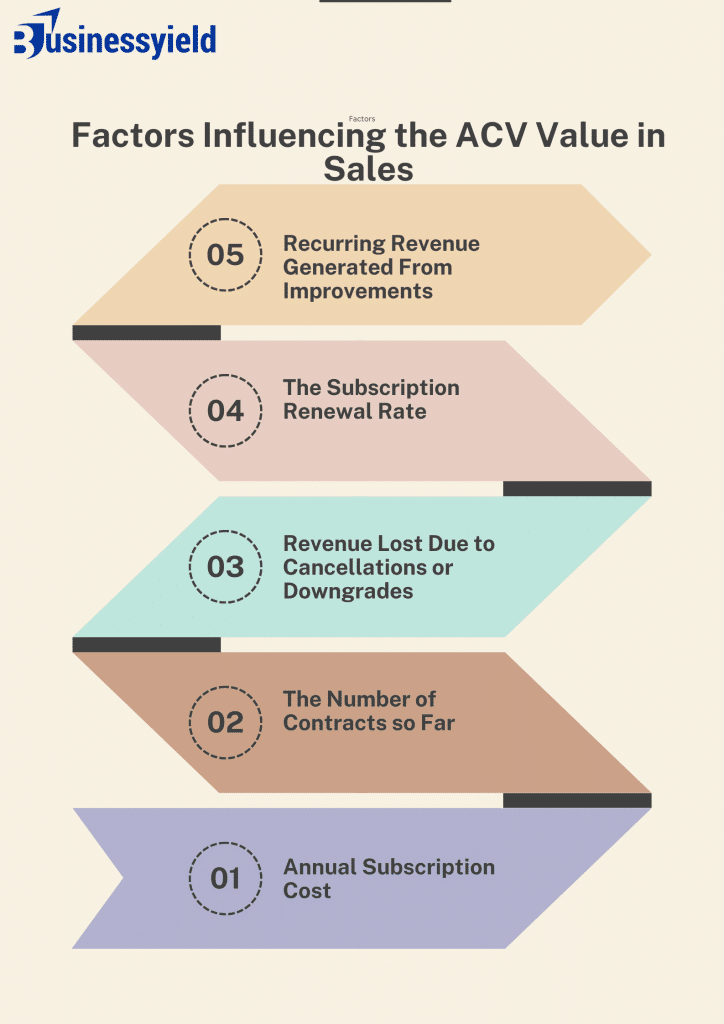Keeping a keen eye on your annual contract value (ACV) metrics is crucial for companies looking to accelerate revenue growth and maximize customer lifetime value. ACV represents the annual value of a customer’s recurring revenue stream – making it one of the most important performance indicators for subscription-based and SaaS businesses.
In this comprehensive guide, I’ll explain exactly what ACV is, why it matters, and how to accurately measure and optimize it through advanced sales strategies. Drawing on years of research into top-performing sales organizations, you’ll also learn proven strategies for increasing initial ACV through effective packaging, pricing, and upselling tactics.
Key Points
- Analyzing the average ACV by account owner provides insight into how your sales reps compare to one another.
- Whether you’ve closed a few high-value client sales or many smaller deals, understanding your current customers might help you estimate your entire revenue.
- When paired with variables like churn rate and upsell opportunities, you can make more precise projections about your financial future.
ACV in Sales Checklist.pdf
What is ACV in Sales?
After careful research, here is a simplified definition of ACV in sales.
ACV stands for Annual Contract Value. It’s an important indicator that organizations use to calculate the income each customer generates per year. Essentially, it indicates how much annual recurring revenue you should expect from a customer depending on the value of their contract.
For example, if you offer a software subscription for $500 per month, the ACV for that customer is $6,000 ($500 multiplied by 12 months). If you have 100 clients paying that amount, your total ACV will be $600,000.
ACV is particularly crucial for organizations that offer subscription-based products or services. Businesses that track and try to raise ACV can more accurately predict recurring income streams and maximize long-term success.
Unlike Average Sales Price (ASP), which can be used to track specific events over time, ACV in sales is employed by SaaS companies that primarily provide annual or multi-year membership plans.
Here is a video I found on YouTube of what I just explained in case you prefer a graphical representation.
How ACV is Used in Sales
As mentioned earlier, ACV, or Annual Contract Value, is a key indicator of future sales performance. But how does it work? Let’s examine its utility in sales forecasting.
Sales teams use ACV to forecast revenue streams from clients annually. It explains how much money they may expect to make from each client contract over the course of a year. This makes it easy to define achievable goals and coordinate corporate strategy accordingly.
That explains why ACV is a crystal ball, providing glimpses into anticipated earnings based on present contracts. You may make more precise projections about your financial future when paired with variables like churn rate and upsell opportunities.
How to Use ACV
This here will help explain better how you can use ACV.
Let’s get into it…
ACV normalizes contract amounts. Thus, you can use it to:
- Compare consumers whose contracts vary in type or term.
- Better serve individual clients, especially those with the highest long-term potential.
- Consider this simple use-case example to help clarify what ACV is in sales.
- Discover which accounts deliver the highest revenue value.
Let’s use this illustration:
Assume you’ve recently closed several subscription-based deals spanning different time periods and dollar amounts and would like a quick estimate of your annual revenue. ACV can help you calculate the average normalized revenue value of every contract you initiate.
Importance of ACV in Sales
#1. Assessing the Performance of Sales Representatives
This is where sales representatives produce various revenue amounts using their bargaining and customer service talents. You can monitor their performance by calculating the ACV for each contract they secure. These insights assist supervisors in conducting performance reviews, determining which sales methods are most effective, and developing effective onboarding and training programs.
#2. Preserve a Loyal Customer Base
Using ACV to identify important clients can also help improve retention rates. Keeping high-performing clients can be more cost-effective than trying to attract new ones. For example, I have a couple of clients I write for, and as soon as I notice the year is about to end my contract with them, I search for strategies to maintain the connection.
Meanwhile, effective techniques also include upselling products and leveraging incentives to drive renewals.
#3. Facilitate the Needs of High-performing Clients
Every organization has limited resources to manage customer relationships. So, consider employing the ACV statistic to find high-performing clients when looking for an efficient resource allocation.
Businesses might utilize this data to select clients with the highest annual income.
This is something that often drives my decision regarding my customer retention strategies and efforts.
For example, a client of mine, Nancy, had an ACV of $35,000, and Judith had an ACV of $20,000. I had to provide greater customer assistance to Nancy because she was a high-performing client.
What is ARR
ARR (annual recurring revenue) is a number that measures the amount of recurring money generated by all of your subscription accounts.
ARR Calculations:
- Measure the entire financial value of your recurring revenue every year.
- Do not include one-time fees or costs.
- Allow you to measure your revenue at a certain point in time.
How to Use ARR
Because it reflects predictable annual revenue, ARR is a useful financial health metric. You can also use it for:
- Track revenue growth over time.
- Forecast revenue by identifying income swings from subscription renewals upsells, and cancellations.
- Analyze and enhance your sales, marketing, and retention tactics.
ACV vs ARR
ACV is the yearly worth of one contract over its subscription duration. In contrast, annual recurring revenue
ARR is the amount a company earns from all contracts in a year. This distinction makes ARR less effective for assessing individual performance and more valuable for tracking annual revenue. Companies frequently use ARR to calculate revenue growth and make more generic budgeting decisions.
For example, if a company has five clients with ACVs of $1,000, $4,000, $10,000, $15,000, and $25,000. Like the illustration I made earlier about Nancy and Judith. The company uses this data to allocate the greatest resources to the client with the highest ACV and prioritize contract renewal. The ARR for these three clients is the total of their ACVs, which is $25,000. The corporation can use this information to design its budget and calculate the expected profit based on the forecasted revenue.
How to use ACV to Enhance Decision-making
Judging from all I have explained, it is clear that the ACV is an essential financial ratio for analyzing a company’s strategy. By better understanding the levers influencing revenue, you can use it to improve sales and marketing decision-making.
#1. Assess the Performance of the Sales Representatives
Top sales representatives do not need discounts to complete every transaction. However, if your sales representatives overuse pricing as a customer acquisition strategy, it will begin to eat into your revenues.
Analyzing the average ACV by account owner provides insight into how your sales reps compare to one another. You may also look at account manager performance to determine which reps frequently find cross-sell and upsell possibilities with your existing customer base.
#2. Evaluate Upsell Opportunities
Pricing discounts are one of the most successful sales strategies you can employ, and they are frequently useful for acquiring significant clients.
My recent research on Key Bank Capital’s 2021 SaaS Metrics Report shows that most SaaS companies generate 36% of their net income from existing customers. As firms grow, upselling becomes an increasingly essential revenue stream.
Tracking per-customer ACV information allows you to uncover profitable upsell chances. For example, if you have an engaged customer with a lower-than-average ACV, your account management and sales teams can collaborate with customer success to propose an upgrade.
Who Needs to Use ACV and ARR, and for what?
Who can profit from learning concepts such as ARR and ACV?
Well, they include SaaS sales, marketing, and management professionals, startups, and most B2B enterprises using a subscription model. Individually, they include:
- Customer service representatives and sales managers
- C-suite executives include VPs of Marketing and Sales
- CEOs, CFOs, and CSOs.
#1. The Sales representatives
As a sales representative, you may utilize ACV to examine your customer base and identify which accounts will most likely benefit from your prompt attention.
If you discover low or high-value clients, for example, or accounts nearing the end of their term, you could:
- Implement a retention strategy.
- Negotiate a contract extension.
- As previously stated, you can also utilize ACV to estimate and measure your annual sales revenue.
#2. Sales and Marketing Managers
As a manager, you can profit from combining KPIs like ACV and ARR with a variety of sales dashboard designs to:
- Monitor your team’s performance.
- Adjust your training efforts.
- Create more profitable decisions or department suggestions.
#3. C-Suite Executives
As someone who assists with corporate finances, you can use year-over-year ARR comparisons to improve the timing and estimates around:
- Annual budgets and future revenue estimates (such as in financial services forecasting)
- Large capital expenditures.
- Hiring additional people and valuing the company.
- Staying on top of your ARR indicators helps you determine when a new capital injection, such as a loan or investment, is necessary.
Factors Influencing the ACV Value in Sales
The number of clients and recurring revenue determines the ACV contract value. Here are the top criteria that influence the ACV value in sales:

#1. Annual Subscription Cost
Understanding the subscription cost is critical to calculating a SaaS company’s ACV. The cost includes the subscription plan chosen by the customer for the specified time and the total of additional upgrades, downgrades, and canceled customer subscriptions.
#2. The Number of Contracts so Far
This is one of the major areas you must keep track of the number of contracts in the pipeline, just like you do with clients. However, it is important to note that the client contracts you track must be active. These active contract values can help you meet your annual revenue targets.
Also, knowing the number of active contracts in the pipeline allows you to determine how many more contracts you need to meet your yearly revenue objective.
#3. Revenue Lost Due to Cancellations or Downgrades
This is also a major area; when clients quit their subscriptions, the SaaS provider experiences churn.
Ensuring your focus is on cancellations or downgrades is equally vital for your business because you must remove this amount from the revenue earned to compute the ARR. This is a critical step in ensuring the financial health of your SaaS firm.
#4. The Subscription Renewal Rate
Are the clients renewing their subscriptions? If consumers do not renew their subscriptions, your ARR will be impacted. As a result, you should emphasize the contract renewal rate over the duration of the contract.
For example, if you have 85 active accounts for renewal but 12 of them cancel their subscription, you will still have 73 active clients. Therefore, the subscription renewal rate will be 95.8%.
However, if eight clients, instead of two, canceled their subscriptions, your subscription renewal rate would be 93.5%.
If you observe, the subscription renewal rate varies with the amount of downgrades or customer attrition. So, to raise your ACV in sales, focus on lowering subscription cancellations.
#5. Recurring Revenue Generated From Improvements
Recurring revenue is the overall money earned by the customer base monthly and yearly, consistent with the subscription and any further add-ons or upgrades they selected.
This is key to improving the annual contract value (ACV). By focusing on this essential component, you can determine the organization’s recurring sales income and the percentage of that revenue from upgrades.
#6. The Number of Customers
The number of clients is directly related to the sales ACV. Whether you’ve closed a few high-value client sales or many smaller deals, understanding your current customers might help you estimate your entire revenue.
Pros and Cons of ACV in Sales
Pros of ACV in Sales
#1. Faster Transaction Sizes and Bigger Contracts
I have experienced that getting into target firms may appear daunting when the account-based GTM model is implemented appropriately. I strongly believe that deal cycles should be shortened and contracts should be larger.
Put another way, strategic accounts (those with higher income potential) have more white space that can be used to generate further transactions beyond the first. Sales teams collaborating with internal teams to surround and build relationships with an account will succeed.
#2. Individualization and Customization
You’ll discover that account-based selling allows you to tailor your sales and marketing efforts to individual accounts’ distinct needs and preferences and your ideal client profile. This level of customization improves client connections and raises the likelihood of successful conversion. Talking about specific challenges/pain points based on persona and industry is a good start. Leveraging success stories for clients in similar industries and sizes has a significant influence.
#3. Sales Efficiency
Account-based selling allows your sales team to focus on high-value accounts, boosting the likelihood of successful transactions with these essential clients. Concentrating resources where they are most needed can result in a big increase in revenue.
Building the list is the core of this strategy, and having a clear understanding of your ideal customer profile and the accounts most likely to need and purchase your product is critical. Marketing and sales must be completely aligned on the top accounts and the strategy for moving them through the sales process.
Cons of ACV in Sales
#1. You Will Need a Lot More Content
In this aspect, you need relevant content that addresses your target audience’s requirements and interests. When pursuing significant target accounts and communicating with various stakeholders at multiple levels, the trouble is that you’ll require even more specialized content than usual.
It’s not just the amount of substance that matters. You need a mechanism to manage this content so potential consumers can see the most relevant stuff. Each stakeholder in a target audience is unique. Even within the same business unit, decision-makers may have different priorities or concerns most important to them.
#2. The ROI is not there for smaller accounts and deals.
Lastly, account-based sales and marketing methods require additional resources; thus, the ROI will be limited if the target firm or deal size is insufficient.
This is where sales strategists must create a qualifying list of high-value accounts with the size and purchasing power to justify the additional resources required for ABS.
Of course, your organization’s sales ambitions determine the minimum deal size or company size. Whatever the statistics, your sales funnel must be designed for the correct type of consumer.
What does ACV stand for in sales?
Annual contract value (ACV) is a sales metric used in the SaaS sector, sometimes known as “ACV bookings.” It represents a client subscription’s average annual contract value.
What is the ACV rate of sale?
ACV refers to a retailer’s total sales (in dollars) inside a specified market. Instead of categorizing the products sold by the store, this measurement covers them all. ACV is commonly referred to as %ACV for CPG brands and provides a weighted value for products in specific retailers.
What is ACV in revenue?
ACV (Annual Contract Value) is a revenue measure that describes how much income you receive from a specific customer each year. ACV can be utilized for annual or monthly subscriptions, tiered or flat-rate pricing, and multi-year contracts.
Conclusion
So far, we’ve come a long way in our study of ACV (Annual Contract Value) in sales. We dug deep into what it is, how to calculate it, and how it compares to other crucial sales indicators. Hasn’t this been an insightful journey?
However, let us not forget the lessons learned about the factors influencing ACV. It is critical to have a balanced perspective when measuring your company’s success.






